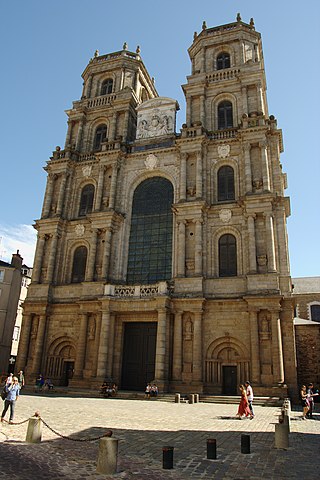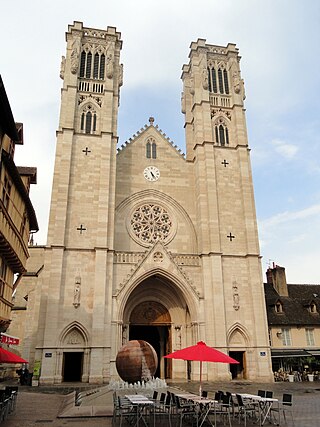
The former French Catholic diocese of Riez existed at least from fifth century Gaul to the French Revolution. Its see was at Riez, in the modern department of Alpes-de-Haute-Provence.

The former French Catholic diocese of Riez existed at least from fifth century Gaul to the French Revolution. Its see was at Riez, in the modern department of Alpes-de-Haute-Provence.
According to an unsupported tradition, the establishment of the Church in this diocese is attributed to the first century and to Eusebius of Eudochius, companion of Lazarus, who had been raised from the dead by Christ himself. [1] A certain Prosper of Reggio of Reggio in Emilia (at the beginning of the fifth century) figures in the history of Riez and was perhaps its bishop. [2]
The first certainly known bishop of Riez is Maximus (433-60), who succeeded Honoratus as Abbot of Lérins and who, in November 439, held a synod at Riez with a view to regularizing the situation of the churches of Southern Gaul, particularly the competing ambitions of the metropolitans of Embrun and Arles. The synod was presided over by Archbishop Hilary of Arles. [3]
His successor, Faustus of Riez (461-93), also Abbot of Lérins, was noted for his writings against Predestinationists; it was to him that Sidonius Apollinaris dedicated his "Carmen Eucharisticum" in gratitude for hospitality received at Riez. [4]
Robert Ceneau, the pulpit orator (1530–32), afterwards Bishop of Avranches, and Cardinal Guido Bentivoglio (1622–25), who was nuncio in France and defender of French interests at Rome, were bishops there. [5]
In 1693 the number of residents in Riez was approximately 6,000, many of whom were Protestants. They were all subjects of the temporal power of the Bishop of Riez. [6] The entire diocese contained 52 named localities, and 60 parishes (including 5 rural priories). [7] In 1751, 3,000 faithful Christians (Catholics) are reported, and the diocese contained 54 parishes. [8]

The Roman Catholic Diocese of Meaux is a diocese of the Latin Rite of the Roman Catholic Church in France. The diocese comprises the entire department of Seine-et-Marne. It was suffragan of the Archdiocese of Sens until 1622, and subsequently of Archdiocese of Paris.

The Archdiocese of Bordeaux (–Bazas) is a Latin Church ecclesiastical territory or archdiocese of the Catholic Church in France. The episcopal see is Bordeaux, Aquitaine. It was established under the Concordat of 1802 by combining the ancient Diocese of Bordeaux with the greater part of the suppressed Diocese of Bazas. The Archdiocese of Bordeaux is a metropolitan see, with four suffragan dioceses in its ecclesiastical province: Dioceses of Agen, Aire and Dax, Bayonne, and Périgueux.

The Diocese of Gap and Embrun is a Latin Church ecclesiastical territory or diocese of the Catholic Church in Provence-Alpes-Côte d'Azur region of Southern France.

The Catholic Diocese of Fréjus–Toulon is a diocese of the Latin Rite of the Catholic Church in southeastern France on the Mediterranean coast. The present diocese comprises the territory of the ancient Diocese of Fréjus as well as that of the ancient Diocese of Toulon. In 1957 it was renamed as the Diocese of Fréjus–Toulon.

The Diocese of Digne is a Latin Church ecclesiastical territory or diocese of the Catholic Church in France. Erected in the 4th century as the Diocese of Digne, the diocese has been known as the Diocese of Digne–Riez–Sisteron since 1922. The diocese comprises the entire department of Alpes-de-Haute-Provence, in the Region of Provence-Alpes-Côte d'Azur. The diocese was a suffragan diocese of the Archdiocese of Aix-en-Provence and Arles until 2002 and is now a suffragan diocese in the ecclesiastical province of the metropolitan Archdiocese of Marseille. The Bishop of Digne's cathedra is found in Digne Cathedral at the episcopal see of Digne-les-Bains.

The Archdiocese of Aix-en-Provence and Arles is a Latin Church ecclesiastical territory or archdiocese of the Catholic Church in France. The archepiscopal see is located in the city of Aix-en-Provence. The diocese comprises the department of Bouches-du-Rhône, in the Region of Provence-Alpes-Côte d'Azur. It is currently a suffragan of the Archdiocese of Marseilles and consequently the archbishop no longer wears the pallium.

The Roman Catholic Diocese of Nice is a diocese of the Latin Church of the Roman Catholic Church in France. The diocese comprises the Départment of Alpes-Maritimes. The diocese is a suffragan of the Archdiocese of Marseille.

The Roman Catholic Diocese of Bayeux and Lisieux is a diocese of the Catholic Church in France. It is coextensive with the Department of Calvados and is a suffragan to the Archdiocese of Rouen, which is also in Normandy.

The Roman Catholic Diocese of Amiens is a diocese of the Latin Rite of the Roman Catholic Church in France. The diocese comprises the department of Somme, of which the city of Amiens is the capital.

The Diocese of Châlons is a Latin Church ecclesiastical territory or diocese of the Catholic Church in Châlons-sur-Marne, France. The diocese comprises the department of Marne, excluding the arrondissement of Reims.

The Archdiocese of Marseille is a Latin Church ecclesiastical jurisdiction or archdiocese of the Catholic Church in France. The archepiscopal see is in the city of Marseille, and the diocese comprises the arrondissement of Marseille, a subdivision of the department of Bouches-du-Rhône in the Region of Provence-Alpes-Côte d'Azur.

The Roman Catholic Diocese of Viviers is a diocese of the Latin Rite of the Roman Catholic Church in France. Erected in the 4th century, the diocese was restored in the Concordat of 1822, and comprises the department of Ardèche, in the Region of Rhône-Alpes. Currently the diocese is a suffragan of the Archdiocese of Lyon. Its current bishop is Jean-Louis Marie Balsa, appointed in 2015.

The Roman Catholic Archdiocese of Poitiers is an archdiocese of the Latin Rite of the Catholic Church in France. The archepiscopal see is in the city of Poitiers. The Diocese of Poitiers includes the two Departments of Vienne and Deux-Sèvres. The Concordat of 1802 added to the see besides the ancient Diocese of Poitiers a part of the Diocese of La Rochelle and Saintes.

The Archdiocese of Auch-Condom-Lectoure-Lombez, more commonly known as the Archdiocese of Auch, is a Latin Church ecclesiastical territory or archdiocese of the Catholic Church in France. The archdiocese now comprises the department of Gers in south-west France. The archdiocese is a suffragan of the Archdiocese of Toulouse, and the current bishop, who therefore does not wear the pallium, is Maurice Marcel Gardès, appointed in 2004.

The Roman Catholic Archdiocese of Rennes, Dol, and Saint-Malo is a diocese of the Latin Rite of the Roman Catholic Church in France. The diocese is coextensive with the department of Ille et Vilaine. The Archdiocese has 8 suffragans: the Diocese of Angers, the Diocese of Laval, the Diocese of Le Mans, the Diocese of Luçon, the Diocese of Nantes, the Diocese of Quimper and Léon, the Diocese of Saint-Brieuc and Tréguier, and the Diocese of Vannes.

The Roman Catholic Diocese of Nevers is a diocese of the Latin Rite of the Roman Catholic Church in France. The diocese comprises the department of Nièvre, in the Region of Bourgogne.

The former French Catholic diocese of Apt, in southeast France, existed from the fourth century until the French Revolution. By the Concordat of 1801, it was suppressed, and its territory was divided between the diocese of Digne and the diocese of Avignon. Its seat was at Apt Cathedral, in Vaucluse.

The ancient residential diocese of Orange in the Comtat Venaissin in Provence, a fief belonging to the Papacy, was suppressed by the French government during the French Revolution. It was revived in 2009 as a titular see of the Roman Catholic Church.

The former French Catholic diocese of Grasse was founded in the 4th or 5th century as the diocese of Antibes. It was originally suffragan to the Archbishop of Aix, and then to the Archbishop of Embrun. The see moved from Antibes to Grasse in 1244. It remained at Grasse Cathedral until the French Revolution. The diocese was suppressed by the Concordat of 1801, its territory passing to the diocese of Nice.

The former French Catholic diocese of Chalon-sur-Saône existed until the French Revolution. After the Concordat of 1801, it was suppressed, and its territory went to the diocese of Autun. Its see was Chalon Cathedral.